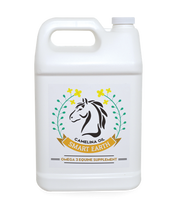No Products in the Cart
Written by: Jessica Konopinski
Published on: 05/23/2024
If you own a miniature horse or know someone who does, you’ve probably heard the hesitation of letting the little creatures out to graze on ample amounts of lush, delicious grass. Why is that? Just like some breeds of typical sized horses, miniature horses and ponies have their own set of predispositions — one being Cushing’s Disease.
Cushing’s Disease is due to issues occuring in a horse’s pituitary gland which is located in the brain. [2] [3] Also referred to as Pars Pituitary Intermedia Dysfunction (PPID), this disorder creates ailments in the endocrine system which is responsible for the release of hormones when the pars intermedia or the middle section of the pituitary gland is enlarged. [2] Located at the bottom of the brain, the pituitary gland is an organ of the endocrine system responsible for the release of hormones. When a horse is suffering from Cushing’s Disease, the pituitary gland is producing excess ACTH (adrenocorticotropic hormone) which increases cortisol levels, leading to signs of Cushing’s Disease. [2]
Even if you believe you’ve never seen a horse or pony with Cushing’s Disease, you probably have as it is much more common than you would think. The first and most common sign that a horse has cushings is the appearance of an abnormal hair coat. This can appear as thick, curly, dull or a long coat. This may not seem like a big issue and can be commonly overlooked. Another sign can be delayed shedding of a winter coat or no shedding at all. [2] This abnormal coat behavior is known as “hirsutism”. [1]
Some other signs include abnormal fat distribution, increased thirst, “pot -belly”, increased urination, skin and dental issues. Since cushings decreases the immune system, horses and ponies may be more prone to develop worms. [2]
While Cushing’s Disease may not be completely preventable due to some horses and ponies predisposition, there are absolutely some precautions you can take to eliminate or improve early signs. Ponies have shown improvement from symptoms of the disease by having a primarily forage based diet of grass hay. This diet also includes the elimination of grain and most grazing. A low carbohydrate diet is key in preventing the onset of Cushing's Disease or in order to eliminate worsening of the condition. [3]
Regular exercise and weight management to prevent any skeletal abnormalities and stress on the joints can be a great addition to diet changes. If your pony or horse's environment does not allow for limited grazing, you can try implementing a grazing muzzle or limit them to grazing overnight since sugar levels in the grass are lowest during these hours. [3]
A ration balancer is a great way to provide your pony with enough vitamins and minerals without the added calories. If you do not have a dry lot for your pony to be outside as much as possible without the stress of consuming high sugar grass, adding a grazing muzzle works great for most if you are unable to adjust turnout hours. Overall, ensuring your pony receives regular exercise, enough nutrients and socialization will ensure optimal health and happiness along with working alongside your trusted veterinarian. [3]
✅ Single ingredient, 100% pure Camelina Oil.
✅ Non-GMO
✅ Ideal balance of Omega-3 compared to other products, like soybean oil.
✅ Canadian produced and operated.
✅ Single ingredient, 100% pure Camelina Oil.
✅ Non-GMO
✅ Ideal balance of Omega-3 compared to other products, like soybean oil.
✅ Canadian produced and operated.
Still have questions? Check out our FAQ's.
Jessica is a brand consultant who brings awareness and intention to equestrian and pet platforms. As a former collegiate equestrian athlete and animal lover, Jessica leads with passion and experience through her writing and brand work for companies who advocate for creating a difference in their space. When she's not riding her horse or walking her dog (with iced coffee in hand), you can find her sharing her love for health and wellness with others and integrating these practices in her everyday work.
